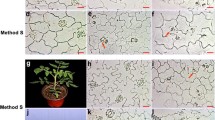Summary
Guard cells and epidermal cells of the abaxial (lower) and adaxial (upper) epidermis ofPisum sativum L., mutant Argenteum, are the predominant sites of flavonoid accumulation within the leaf. This was demonstrated by the use of a new method of simultaneous isolation and separation of intact, highly-purified guard cell and epidermal cell protoplasts from both epidermal layers and of protoplasts from the mesophyll. Isolated guard and epidermal protoplasts retained flavonoid patterns of the parent epidermal tissue; quercetin 3-triglucoside and its p-coumaric acid ester as major constituents, kaempferol 3-triglucoside and its p-coumaric acid ester as minor compounds. Total flavonoid content in the lower epidermis was estimated to be ca. 80 fmol per guard cell protoplast and 500 fmol per epidermal cell protoplast. Protoplasts isolated from the upper epidermis had about 20–30% as much of these flavonoids. Mesophyll protoplasts retained only about 25 fmol total flavonoid per protoplast.
By fluorescence microscopy, using the alkaline-induced yellow-green fluorescence characteristics of flavonols, we suggest that these flavonol glycosides are present in cell vacuoles. There was no indication for the presence of flavine-like compounds.
Similar content being viewed by others
Abbreviations
- uE:
-
adaxial (upper) epidermis
- IE:
-
abaxial (lower) epidermis
- GCP:
-
guard cell protoplasts
- ECP:
-
epidermal cell protoplasts
- MCP:
-
mesophyll cell protoplasts
- PP:
-
protoplasts
- HPLC:
-
high performance liquid chromatography
- TLC:
-
thin layer chromatography
- CC:
-
column chromatography
- HOAc:
-
acetic acid
References
Egger K, (1967) Pflanzliche Phenolderivate I. In:Stahl E (ed) Dünnschichtchromatographie. Springer, Berlin Heidelberg New York, pp 655–673
Flint SD, Jordan PW, Caldwin MM, (1985) Plant protective response to enhanced UV-B radiation under field conditions: leaf optical properties and photosynthesis. Photochem Photobiol 41: 95–99
Furuya M, Galston AW, (1965) Flavonoid complexes inPisum sativum L. I. Nature and distribution of the major components. Phytochemistry 4: 285–296
Ghisla S, Mack R, Blankenhorn G, Hemmerich P, Krienitz E, Kuster T, (1984) Structure of a novel flavin chromophore fromAvena coleoptiles, the possible “blue light” photoreceptor. Eur J Biochem 138: 339–344
Heller F-O, Kausch W, (1971) Licht- und ultraviolettmikroskopische Beobachtungen an Schließzellen nach ihrer Reaktion auf verschiedene Umweltbedingungen. Ber Dtsch Bot Ges 84: 541–549
Hewitt EI, Smith TA, (1974) Plant mineral nutrition. English Universities Press Ltd, London
Hrazdina G, Marx GA, Hoch HC, (1982) Distribution of secondary plant metabolites and their biosynthetic enzymes in pea (Pisum sativum L.) leaves. Anthocyanin und flavonol glycosides. Plant Physiol 70: 745–748
Jewer PC, Incoll LD, Shaw I, (1982) Stomatal response of Argenteum—a mutant ofPisum sativum L. with readily detachable leaf epidermis. Planta 155: 146–153
Knogge W, Weissenböck G, (1986) Tissue-distribution of secondary phenolic biosynthesis in developing primary leaves ofAvena sativa L. Plants 167: 196–205
Kof EM, Laman NA, Kefeli VI, (1976) On the flavonoid complex of green and etiolated pea (Pisum sativum L.). Dokl Akad Nauk USSR 228: 505–508
Mabry TJ, Markham KR, Thomas MB, (1970) The systematic identification of flavonoids. Springer, Berlin Heidelberg New York
Metzner P, (1930) Über das optische Verhalten der Pflanzengewebe im langwelligen UV-Licht. Planta 10: 281–313
Ninnemann H, (1980) Blue light photoreceptors. Bio Sci 30: 166–170
Peyron D, Tissut M, (1981) Le metabolisme des flavonoides de la plantule de Pois. Physiol Vég 19: 315–326
Popovici G, Weissenböck G, Bouillant M-L, Dellamonica G, Chopin J, (1977) Isolation and characterization of flavonoids fromAvena sativa L. Z Pflanzenphysiol 85: 103–115
Schnabl H, Weissenböck G, Scharf H, (1986)In vivo- microspectrophotometric characterization of flavonol glycosides inVicia faba guard and epidermal cells. J Exp Bot 37: 61–72
Schulz M, Weissenböck G, (1986) Isolation and separation of epidermal and mesophyll protoplasts from rye primary leaves; tissue-specific characteristics of secondary phenolic product accumulation. Z Naturforsch 41 c: 22–27
Statham CM, Crowden RK, Harborne JB, (1972) Biochemical genetics of pigmentation inPisum sativum. Phytochemistry 11: 1083–1088
Stitt M, Wirtz W, Gerhardt R, Heldt HW, Spencer C, Warker P, Foyer C, (1985) A comparative study of metabolic levels in plant leaf material in the dark. Planta 166: 354–364
Vierstra RD, John TR, Poff KL, (1982) Kaempferol 3-0-galactoside, 7-0-rhamnoside is the major green fluorescing compound in the epidermis ofVicia faba. Plant Physiol 69: 522–525
Weissenböck G, Schnabl H, Sachs G, Elbert C, Heller F-O, (1984) Flavonol content of guard cell and mesophyll cell protoplasts isolated fromVicia faba leaves. Physiol Plant 62: 356–362
Zeiger E, (1981) Novel approaches to the biology of stomatal guard cells: protoplast and fluorescent studies. In:Mansfield T, Jarvis P (eds) Stomatal physiology. Cambridge University Press, Cambridge, pp 103–117
—, (1983) The biology of stomatal guard cells. Ann Rev Plant Physiol 34: 441–475
Author information
Authors and Affiliations
Rights and permissions
About this article
Cite this article
Weissenböck, G., Hedrich, R. & Sachs, G. Secondary phenolic products in isolated guard cell, epidermal cell and mesophyll cell protoplasts from pea (Pisum sativum L.) leaves: Distribution and determination. Protoplasma 134, 141–148 (1986). https://doi.org/10.1007/BF01275712
Received:
Accepted:
Issue Date:
DOI: https://doi.org/10.1007/BF01275712




